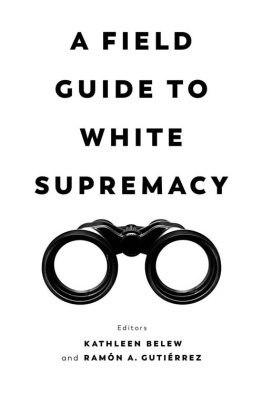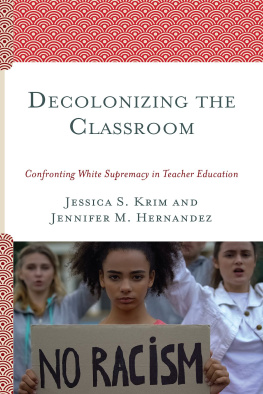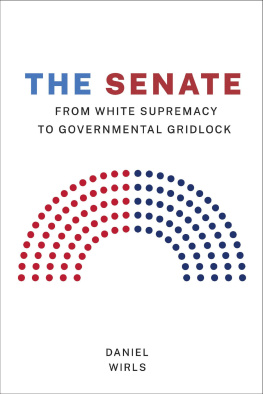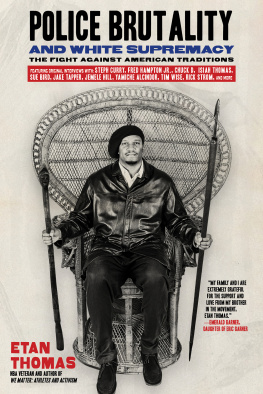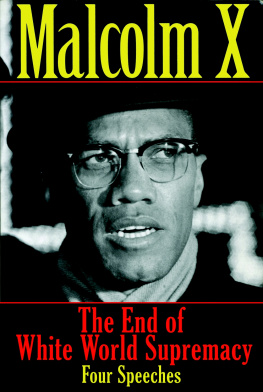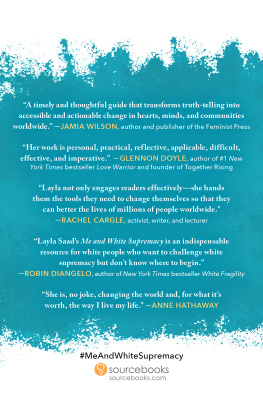Kathleen Belew - A Field Guide to White Supremacy
Here you can read online Kathleen Belew - A Field Guide to White Supremacy full text of the book (entire story) in english for free. Download pdf and epub, get meaning, cover and reviews about this ebook. year: 2021, publisher: University of California Press, genre: Politics. Description of the work, (preface) as well as reviews are available. Best literature library LitArk.com created for fans of good reading and offers a wide selection of genres:
Romance novel
Science fiction
Adventure
Detective
Science
History
Home and family
Prose
Art
Politics
Computer
Non-fiction
Religion
Business
Children
Humor
Choose a favorite category and find really read worthwhile books. Enjoy immersion in the world of imagination, feel the emotions of the characters or learn something new for yourself, make an fascinating discovery.
- Book:A Field Guide to White Supremacy
- Author:
- Publisher:University of California Press
- Genre:
- Year:2021
- Rating:5 / 5
- Favourites:Add to favourites
- Your mark:
- 100
- 1
- 2
- 3
- 4
- 5
A Field Guide to White Supremacy: summary, description and annotation
We offer to read an annotation, description, summary or preface (depends on what the author of the book "A Field Guide to White Supremacy" wrote himself). If you haven't found the necessary information about the book — write in the comments, we will try to find it.
A Field Guide to White Supremacy — read online for free the complete book (whole text) full work
Below is the text of the book, divided by pages. System saving the place of the last page read, allows you to conveniently read the book "A Field Guide to White Supremacy" online for free, without having to search again every time where you left off. Put a bookmark, and you can go to the page where you finished reading at any time.
Font size:
Interval:
Bookmark:

The publisher and the University of California Press Foundation gratefully acknowledge the generous support of the Lawrence Grauman, Jr. Fund.
Edited by Kathleen Belew and Ramn A. Gutirrez

UNIVERSITY OF CALIFORNIA PRESS
University of California Press
Oakland, California
2021 by Kathleen Belew and Ramn A. Gutirrez
Chapter 1 was previously published in NAIS: Journal of the Native American and Indigenous Studies Association 6, no. 2 (Fall 2019). Chapter 2 was previously published in Keeanga-Yamahtta Taylor, From #BlackLivesMatter to Black Liberation (Haymarket, 2016). Chapter 5 is reprinted from A Rape a Minute, a Thousand Corpses a Year, Guernica , January 25, 2013. Chapter 6 originally appeared in Slate , May 1, 2018. Chapter 10 was previously published as the foreword to On Antisemitism: Solidarity and the Struggle for Justice by Judith Butler and Jewish Voices for Peace (Haymarket, 2017). Chapter 15 is excerpted and updated from Adam Goodman, The Deportation Machine: Americas Long History of Expelling Immigrants (Princeton, NJ: Princeton University Press, 2020)
Library of Congress Cataloging-in-Publication Data
Names: Belew, Kathleen, 1981- author. | Gutirrez, Ramn A., 1951- author.
Title: A field guide to white supremacy / Kathleen Belew and Ramn A. Gutirrez.
Description: Oakland, California : University of California Press, [2021] | Includes bibliographical references and index.
Identifiers: LCCN 2020058505 (print) | LCCN 2020058506 (ebook) | ISBN 9780520382503 (cloth) | ISBN 9780520382527 (paperback) | ISBN 9780520382534 (ebook)
Subjects: LCSH : White supremacy movementsUnited States. | Anti-racismUnited States.
Classification: LCC E 184. A 1 B 348 2021 (print) | LCC E 184. A 1 (ebook) | DDC 320.56/909dc23
LC record available at https://lccn.loc.gov/2020058505
LC ebook record available at https://lccn.loc.gov/2020058506
Manufactured in the United States of America
30 29 28 27 26 25 24 23 22 21
10 9 8 7 6 5 4 3 2 1
SECTION I
SECTION III
As the field standard for journalists, the Associated Press Stylebook plays a major role in fixing the parameters of political debate and imagination. Consider that the most recent edition included contextual entries as long as a paragraph for the Islamist terror groups Al Qaeda, Islamic State, and the Muslim Brotherhood, but no entries for the white power terror groups Ku Klux Klan or neo-Nazis. White power activists have carried out an overwhelming majority of domestic terror fatalities and attacks in recent years, and the Department of Homeland Security now considers these the largest terrorist threat to the United Statesoutstripping radical Islamist terrorism.
Yet journalists using the AP Stylebook are ill-equipped to describe white power and militia groups. Our aim in this section is to briefly provide journalists with an overview of the terms and understandings agreed upon by most scholarly specialists and to encourage the editors of the Stylebook to reconsider some of the books guidance.
On close reading of the AP Stylebook , we noticed that scholars and journalists often use completely different language to discuss the same social problems. The recommendations here, focused on the terminology and reporting around race, gender, immigration, and political extremism, are meant as a starting point in what we hope will be a longer conversation about how we name and acknowledge white supremacy. In some contexts, we have no recommendations, only questions. In all cases, we welcome feedback from journalists and other scholars in how best to use our shared understanding to achieve clarity and accuracy.
antisemitism
The AP Stylebook currently recommends hyphenating. We disagree, because we understand Semite and Semitism to be invented terms with a long history in pseudoscience.
immigration
We urge consideration and modification of the existing entry. Immigrants are people who move. People who move do so for many reasons: to seek better work opportunities, to reunite with family members, to flee danger or persecution. But the context for immigration involves more than individual choices: inequality, persecution, conflict, war, and exploitation by more powerful countries may frame immigration. Likewise, the United States has policies that draw people; immigration is not something that happens to the United States but is part of a process that has been facilitated by U.S. actors. Often when Americans think about immigration, they are thinking about U.S. policies that manage migration, including both admissions and restrictions. Lawful immigrants outnumber unauthorized immigrants. The United States admits people through a few categories (family, labor, humanitarian). Enforcement and restriction produce the category of undocumented .
We urge the AP Stylebook to discourage the use of immigration metaphors that might inspire fear or disgust or might dehumanize immigrants (flood, stream, wave, tide, swarm, horde, etc).
anti-immigrant (no current entry)
The Stylebook does not currently cover one of the most potent political forces of the moment. Anti-immigrant refers to a group, person, or policy that opposes immigration.
deportation, removal, inadmissibility, and voluntary departure
We urge reporters to use specific terminology around these procedures. For instance, documented immigrants can still be deported.
race
In addition to the current category, Race-related Coverage, we urge the Stylebook to consider defining race itself as a socially constructed category of political identity that has changed over time.
caucasian
This is an outmoded term based on pseudoscience. We urge journalists not to use this term.
Black (capitalized)
Following several prominent media outlets, we agree that Black should be capitalized when it refers to a cultural and racial identity.
Indigenous (capitalized)
Latinx (capitalized)
As the most inclusive and encompassing term, we recommend use of this term, but journalists should defer, when possible, to how people self-identify. Many individuals prefer other terms. Latinx should not be used to refer to people in the past, when the term was not used in self-identification.
reverse discrimination
This term should be used sparingly and in quotation marks. Because racism is a system of power, we see it as incorrect to refer to racism against white people in a white supremacist society. Such arguments often disguise racist policies.
tribe/tribal
These words refer to an Indigenous nation. Do not use tribal to discuss broader political division.
white
The word white refers to a socially constructed and historically fluid category of identity in which people, systems of power, and wealth are invested. This is not a biological or unchangeable category, but neither is it neutral. We struggle with the question of whether to capitalize this word and urge further conversation. We choose not to capitalize white in these pages in keeping with current style guidelines.
white power movement, white supremacist extremist movement
see Terrorism
white supremacist (current entry a subsection of alt-right)
Font size:
Interval:
Bookmark:
Similar books «A Field Guide to White Supremacy»
Look at similar books to A Field Guide to White Supremacy. We have selected literature similar in name and meaning in the hope of providing readers with more options to find new, interesting, not yet read works.
Discussion, reviews of the book A Field Guide to White Supremacy and just readers' own opinions. Leave your comments, write what you think about the work, its meaning or the main characters. Specify what exactly you liked and what you didn't like, and why you think so.

